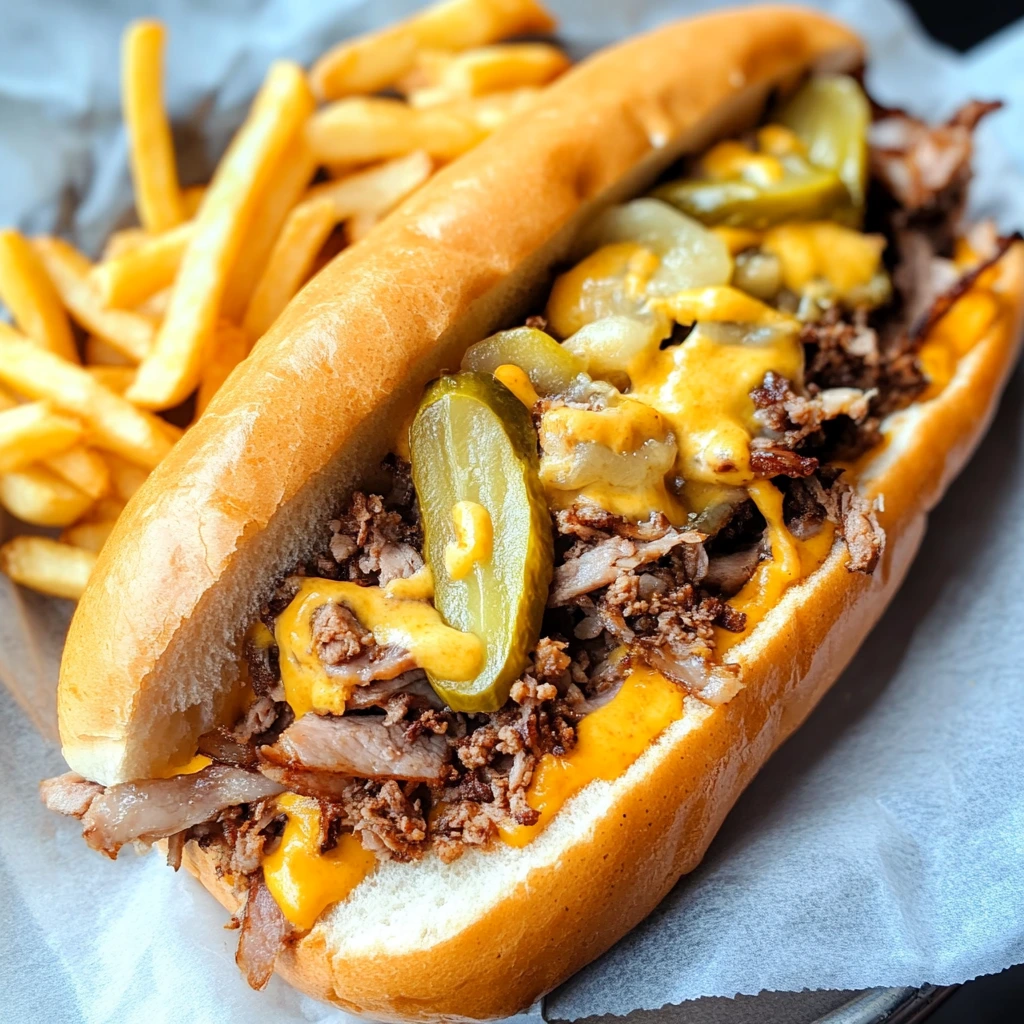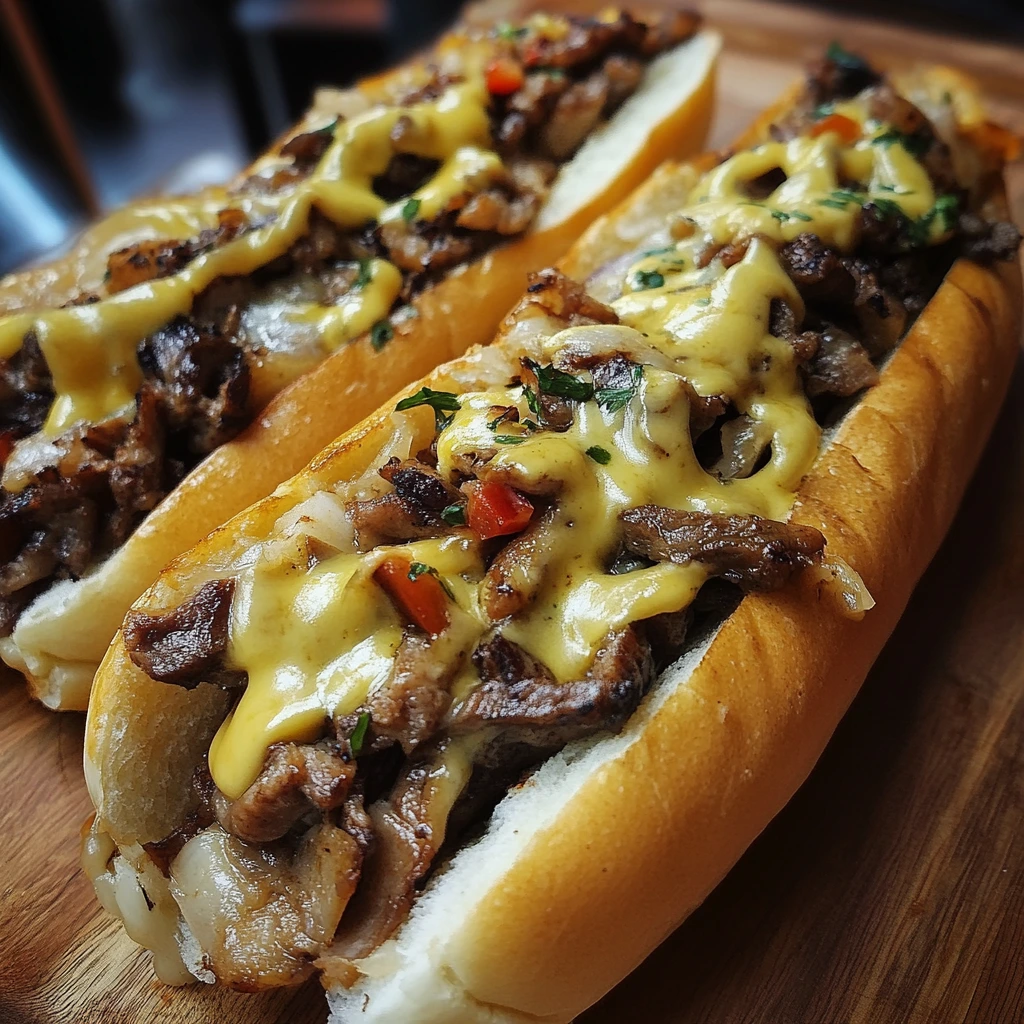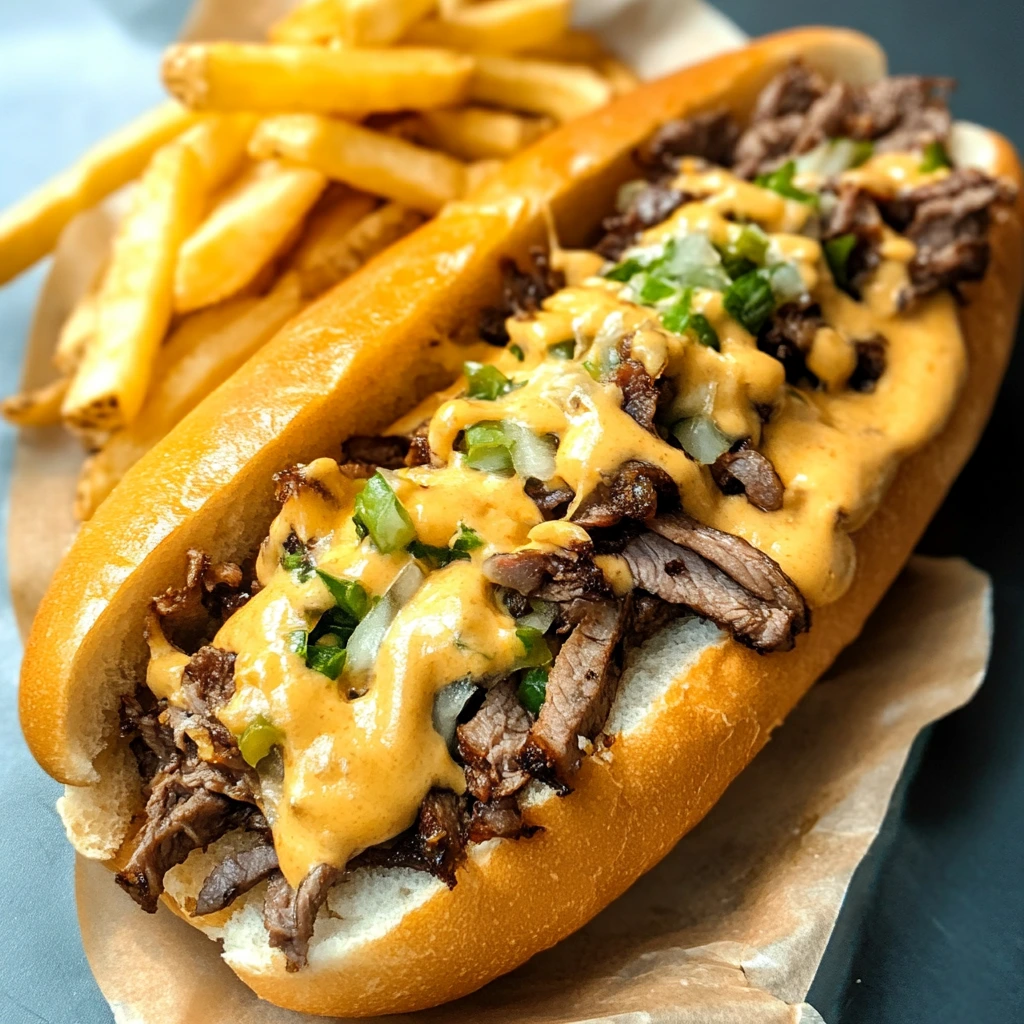The Iconic Cheesesteak – A Sandwich Like No Other
When it comes to legendary sandwiches, the cheesesteak stands in a league of its own. Originating from the streets of Philadelphia, this hearty, flavor-packed sandwich has won the hearts of food lovers across the globe. A perfect cheesesteak combines thinly sliced ribeye steak, melty Cheez Whiz, Provolone, or American cheese, and a soft-yet-sturdy hoagie roll—all cooked to perfection and bursting with rich, savory goodness.
But what makes a homemade cheesesteak just as mouthwatering as the ones from Philly’s famous spots like Pat’s King of Steaks or Geno’s Steaks? The secret lies in choosing the right ingredients, mastering the cooking technique, and assembling the sandwich with precision.
In this guide, we’ll take you through everything you need to know about making the best cheesesteak at home—from selecting the perfect cut of beef to achieving that irresistibly gooey, melty texture. Whether you’re a first-time cook or a cheesesteak enthusiast looking for an easy recipe, this step-by-step guide will help you create a sandwich that rivals the best in Philly!

What Makes a Cheesesteak Truly Authentic?
The History of the Philly Cheesesteak
The Philly cheesesteak was born in 1930 when Pat Olivieri, a hot dog vendor in Philadelphia, decided to grill thinly sliced beef and serve it on an Italian roll. A passing taxi driver tried it, loved it, and word quickly spread. Soon after, Pat and his brother Harry Olivieri opened Pat’s King of Steaks, the first official cheesesteak shop.
Originally, the sandwich didn’t include cheese. It wasn’t until the 1940s that Provolone cheese was added, followed by Cheez Whiz in the 1950s, making it the go-to choice for many.
The rivalry between Pat’s King of Steaks and Geno’s Steaks, which opened in 1966 right across the street, helped solidify the cheesesteak as a Philadelphia icon. Today, this classic sandwich is enjoyed across the U.S., but nothing beats an authentic Philly cheesesteak from its hometown!
The Essential Ingredients for the Best Cheesesteak
A great cheesesteak comes down to quality meat, cheese, bread, and simple toppings.
1. Best Meat for Cheesesteak
- Ribeye steak is the top choice—tender, juicy, and flavorful.
- Sirloin or flank steak can work but may need extra tenderizing.
- Cook on a flat-top grill or cast-iron skillet for the best texture.
2. Best Cheese Options
- Cheez Whiz – The classic Philly favorite, smooth and creamy.
- Provolone – A slightly sharper, traditional option.
- American cheese – Melts well for a rich, buttery taste.
3. Best Bread Choice
- Hoagie rolls or Amoroso’s rolls – Soft yet sturdy enough to hold the filling.
- Lightly toasted for the perfect balance of crisp and chew.
4. Simple Toppings
- Sautéed onions (traditional choice).
- Bell peppers & mushrooms (optional but popular).

How to Make the Best Cheesesteak at Home (Step-by-Step Guide)
Ingredients You Need
| Ingredient | Quantity |
|---|---|
| Ribeye steak (thinly sliced) | 1 lb |
| Hoagie rolls | 2 |
| Cheez Whiz / Provolone / American cheese | 4 slices or ½ cup |
| Onion (sliced) | 1 medium |
| Bell pepper (optional) | ½ sliced |
| Mushrooms (optional) | ½ cup sliced |
| Butter | 1 tbsp |
| Salt & Pepper | To taste |
| Olive oil | 1 tbsp |
Cooking Instructions for a Perfect Cheesesteak
1. Slice the Steak
- Freeze ribeye steak for 15-20 minutes for easier slicing.
- Cut it thinly against the grain for a tender texture.
2. Cook the Veggies (Optional)
- Sauté onions, bell peppers, or mushrooms in oil or butter until soft, then set aside.
3. Cook the Steak
- Heat a cast-iron skillet or flat-top grill on medium-high heat.
- Cook the thinly sliced steak, seasoning with salt and pepper, for 3-4 minutes, stirring occasionally.
4. Melt the Cheese
- Place Provolone, American cheese, or Cheez Whiz over the steak.
- Let it melt naturally or cover for 30 seconds to speed up melting.
5. Assemble & Serve
- Toast the hoagie roll lightly, then fill it with the cheesy steak mixture.
- Add sautéed onions or peppers if desired.
- Serve hot with fries or pickles—enjoy your homemade Philly cheesesteak!

Pro Tips for a Juicier, More Flavorful Cheesesteak
Choosing the Right Steak for the Best Flavor
The key to an authentic, juicy cheesesteak lies in choosing the right cut of beef. The best steak should be tender, flavorful, and easy to slice thinly, ensuring the classic melt-in-your-mouth experience.
1. The Best Cut: Ribeye Steak
- Ribeye steak is the gold standard for cheesesteaks because of its rich marbling, which keeps the meat juicy and flavorful.
- When cooked, the fat renders down, creating a tender texture without becoming dry.
- It’s the same cut used in traditional Philly cheesesteak shops, making it the most authentic choice.
2. Alternative Cuts for Cheesesteak
If ribeye isn’t available, consider these substitutes:
- Sirloin Steak – Leaner than ribeye but still offers good flavor and tenderness.
- Flank Steak – Works well if sliced extra thin but may require a quick marinade to keep it tender.
- Skirt Steak – Similar to flank steak but slightly more tender, though it has a stronger beefy taste.
3. How to Slice the Steak for the Perfect Texture
- For tender, easy-to-eat steak, slice it thinly against the grain.
- To make slicing easier, freeze the steak for 15-20 minutes before cutting.
- A sharp knife or meat slicer ensures clean, thin cuts for the best texture.
4. Cooking the Steak for Maximum Flavor
- Use a flat-top grill or cast-iron skillet for even cooking and browning.
- Cook quickly over high heat to retain juiciness.
- Avoid overcooking—3-4 minutes is enough to keep it tender.
Cooking Techniques for the Ultimate Cheesesteak
1. Use the Right Cooking Surface
- A flat-top grill or cast-iron skillet ensures even cooking and a great sear.
2. High Heat for Quick Cooking
- Preheat to medium-high to lock in juices and prevent drying out.
3. Chop and Flip the Steak
- Sear thinly sliced ribeye for 1-2 minutes, then chop and flip for even cooking.
4. Simple Seasoning
- Salt and pepper enhance the natural flavor; garlic powder or Worcestershire is optional.
5. Melt the Cheese Properly
- Place cheese directly on the steak while still on the grill for perfect melting.
- If using Cheez Whiz, drizzle it on after cooking.
6. Toast the Hoagie Roll
- Lightly toast the roll for 30 seconds to keep it sturdy yet soft.
Master these simple techniques, and you’ll have a restaurant-quality cheesesteak at home!
The Best Cheese for Cheesesteak – Which One Should You Choose?
Choosing the right cheese is key to making an authentic and delicious cheesesteak. The cheese should melt well, complement the steak’s rich flavor, and add a creamy texture to every bite. Here are the top three cheese choices and what makes them unique.
1. Cheez Whiz – The Classic Choice
- Introduced in the 1950s, Cheez Whiz quickly became the go-to cheese for an authentic Philly cheesesteak.
- Its smooth, creamy texture melts perfectly over the steak, creating that signature gooey consistency.
- Most traditional cheesesteak spots, including Pat’s King of Steaks, recommend Cheez Whiz for the best experience.
- Best for: Those who love a rich, velvety, and slightly salty cheese sauce.
2. Provolone – The Traditional Melt
- Provolone cheese offers a mild, slightly tangy flavor with great meltability.
- It’s a favorite among those who prefer a less processed, natural cheese on their sandwich.
- Some cheesesteak lovers opt for sharp provolone for a more intense, aged-cheese flavor.
- Best for: Those who want a classic, slightly sharper taste with a melty texture.
3. American Cheese – The Smooth & Creamy Option
- American cheese provides a buttery, mild taste and melts effortlessly over the steak.
- It’s commonly used in fast-food cheesesteak versions due to its silky texture and rich flavor.
- Unlike Cheez Whiz, it doesn’t have a bold taste but offers a subtle creaminess that enhances the steak.
- Best for: Those who prefer a mild, extra-creamy cheese with a soft texture.
Which Cheese Should You Choose?
- For authentic Philly style: Go with Cheez Whiz.
- For a more traditional cheesesteak: Provolone is the best option.
- For a mild, extra-creamy experience: Choose American cheese.
No matter which cheese you pick, melting it directly over the steak while cooking ensures it blends perfectly into every bite!
Frequently Asked Questions About Cheesesteak
What’s the Best Cheese for a Cheesesteak?
The cheese you choose for a cheesesteak can make all the difference in flavor, texture, and overall experience. While there are many cheese options, three stand out as the most popular and widely used in authentic Philly cheesesteaks: Cheez Whiz, Provolone, and American cheese.
1. Cheez Whiz – The Philly Favorite
- Cheez Whiz is the most authentic choice, widely used in Philadelphia cheesesteak joints, including Pat’s King of Steaks.
- It has a smooth, creamy consistency that melts easily and coats the steak for maximum flavor in every bite.
- Some people find Cheez Whiz too processed, but its bold, salty, and tangy taste is what makes it a Philly classic.
2. Provolone – A Traditional & Flavorful Choice
- Provolone cheese is a favorite for those who prefer a natural, mild cheese with a slightly tangy taste.
- It melts well over hot steak and gives a classic cheesesteak flavor without overpowering the meat.
- Sharp provolone is an option for those who like a stronger, aged-cheese flavor.
3. American Cheese – Buttery & Creamy
- American cheese is known for its ultra-creamy, mild, and slightly buttery flavor.
- It melts effortlessly, creating a silky texture that pairs perfectly with tender steak.
- If you want a smooth, melty, and classic sandwich, American cheese is a great choice.
Which Cheese Should You Choose?
- If you want the most authentic Philly cheesesteak, go with Cheez Whiz.
- If you prefer a milder, more traditional cheese, Provolone is the best pick.
- For a creamy, buttery texture, American cheese is the way to go.
Ultimately, the best cheese for a cheesesteak comes down to personal preference—but no matter which you choose, it should be melty, flavorful, and blend seamlessly with the steak!
Can I Make a Cheesesteak Without Ribeye?
Yes, you can make a cheesesteak without ribeye, but ribeye is considered the gold standard for its tender texture and rich marbling. If you need an alternative, choosing the right cut of beef is key to maintaining the juiciness and flavor that makes a cheesesteak delicious.
1. Best Alternatives to Ribeye
If ribeye isn’t available, try these substitute cuts:
- Sirloin Steak – A leaner option with good flavor, though slightly less tender than ribeye.
- Flank Steak – A flavorful cut that works well when sliced thinly against the grain.
- Skirt Steak – Has a rich, beefy taste but can be chewy if not sliced properly.
- New York Strip – A well-marbled alternative with good tenderness but slightly firmer texture.
2. How to Make Tougher Cuts More Tender
- Slice thinly: The thinner the slices, the more tender the meat will feel when cooked.
- Marinate if needed: Tougher cuts like flank or skirt steak benefit from a quick marinade with a little olive oil, Worcestershire sauce, or vinegar to help break down fibers.
- Cook quickly on high heat: Avoid overcooking—3-4 minutes on a hot grill or skillet keeps the meat tender.
3. Can I Use Ground Beef for a Cheesesteak?
While ground beef isn’t traditional, it can be used as a budget-friendly alternative. Just cook it thoroughly, season well, and melt the cheese directly into the beef to create a cheesy, steak-flavored sandwich.
Final Verdict
While ribeye is the best choice, sirloin, flank, and skirt steak can still make a delicious homemade cheesesteak if sliced thin and cooked properly. The key is retaining juiciness and tenderness to capture the classic cheesesteak experience!
What’s the Best Bread for a Cheesesteak?
The bread is just as important as the steak and cheese when making a perfect cheesesteak. The ideal roll should be soft yet sturdy, able to hold the juicy filling without falling apart. Choosing the right bread ensures the perfect balance of texture and flavor.
1. The Classic Choice: Hoagie Rolls
- Hoagie rolls are the most commonly used bread for authentic Philly cheesesteaks.
- They have a slightly crispy exterior with a soft, chewy interior, making them perfect for holding the steak, melted cheese, and toppings.
- The roll should be long and slightly dense, so it absorbs the juices without getting soggy.
2. Amoroso’s Rolls – The Philly Staple
- Amoroso’s rolls are a Philadelphia classic, used by famous cheesesteak shops like Pat’s and Geno’s.
- They are light and airy inside but strong enough to hold the filling without breaking apart.
- If you want the most authentic Philly experience, Amoroso’s rolls are the top choice.
3. Alternative Bread Options
If you can’t find traditional hoagie rolls, consider these alternatives:
- French Bread – Slightly crispier but works well for cheesesteaks.
- Italian Rolls – Similar to hoagie rolls, offering a chewy texture.
- Soft Sub Rolls – Readily available and good for a quick cheesesteak, but may not hold up as well to the juices.
4. Toasting the Bread for Extra Flavor
- Lightly toasting the inside of the roll adds a slight crunch and helps prevent sogginess.
- Use butter or a little oil on the roll and toast it on a grill or skillet for 30 seconds before assembling.
Can I Make a Cheesesteak Without a Flat-Top Grill?
Yes! While a flat-top grill is the traditional cooking surface for an authentic Philly cheesesteak, you can still achieve great results at home using other cooking methods. The key is high heat, even cooking, and proper searing to get that signature flavor and texture.
Best Alternatives to a Flat-Top Grill
If you don’t have a flat-top grill, these alternatives work just as well:
- Cast-Iron Skillet – The best substitute as it retains heat well, providing an even sear.
- Non-Stick or Stainless Steel Pan – A good option, though it won’t create as deep a crust as cast iron.
- Griddle Pan – Offers more space for cooking steak and onions evenly.
- Outdoor Grill with a Griddle Attachment – Ideal for those who prefer cooking outdoors.
How to Cook a Cheesesteak Without a Flat-Top Grill
- Preheat your skillet or pan over medium-high heat before adding oil or butter.
- Sauté onions and peppers first (if using), then set aside.
- Cook the thinly sliced steak, letting it sear for 1-2 minutes without moving.
- Chop and flip the steak with a spatula for even cooking.
- Melt the cheese directly on the steak or mix it in before assembling.
- Lightly toast the hoagie roll in the same pan for extra flavor.
Tips for the Best Cheesesteak Without a Flat-Top
- Use high heat to cook the steak quickly and retain juiciness.
- Cook in small batches to avoid overcrowding and steaming the meat.
- Avoid overcooking—3-4 minutes is enough for a tender, flavorful steak.

Making a cheesesteak at home is easier than you think, and with the right ingredients and techniques, you can create a sandwich that rivals even the best Philly cheesesteak shops. The key to success lies in choosing quality ribeye steak, melting the right cheese, and using a soft yet sturdy hoagie roll to hold everything together.
Whether you prefer the classic Cheez Whiz, Provolone, or American cheese, the secret to a great cheesesteak is cooking the steak quickly on high heat and letting the cheese melt directly into the meat for maximum flavor. Even if you don’t have a flat-top grill, a cast-iron skillet or griddle works just as well to achieve that authentic, juicy texture.
Now that you have the step-by-step guide, it’s time to put your skills to the test! Try making this easy and delicious homemade cheesesteak, and don’t forget to share your experience. Whether you stick to the traditional recipe or add your own twist, one thing is certain—this iconic sandwich never disappoints!
